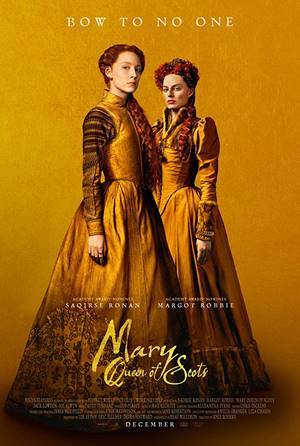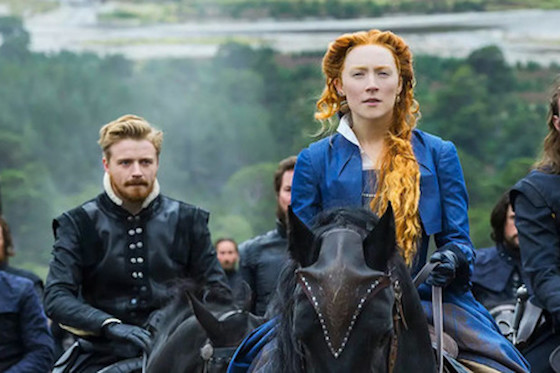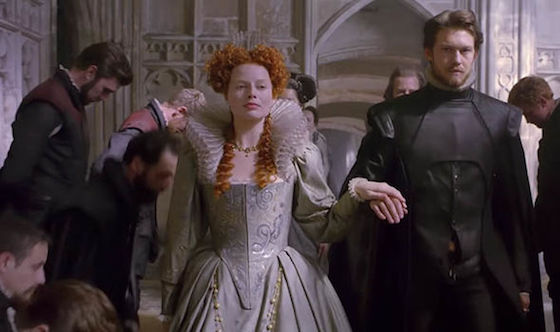
 [Rating: Minor Rock Fist Down]
[Rating: Minor Rock Fist Down]
A deep-in-the-weeds historical epic boasting a difficult protagonist as well as a plot spanning two and a half decades, Mary Queen of Scots takes a big bite, yet finds trouble in the chewing.
A tale of a young queen’s struggle to make it in a man’s world, the movie never seems to know what to make of its characters, the eponymous one in particular. And despite some interesting source material, layers of political intrigue pile up with exhaustive abundance until the production collapses under the weight of its own ambitions, leaving just a few decent performances and a superb hair, costume, and makeup effort as salvageable.
Not long after the film opens, Mary Stuart (Saoirse Ronan) returns to Scotland following the dissolution of her political marriage in France. A young woman with no experience in her own court, Mary nevertheless shows herself to be a confident, intelligent, headstrong leader who’s more than capable of ruling her small fiefdom. As a Catholic, she’s in the social and political minority, yet this also positions her as a viable rival to her cousin, Queen Elizabeth of England (Margot Robbie). Elizabeth’s position as a Protestant monarch makes her an enemy of Rome and Spain, after all, so both women tread with deliberate purpose when dealing with the other.
The main thrust of the film’s drama comes out of Mary’s push to have Elizabeth recognize her, and later, her son James, as the successor to the English throne. With no husband or children of her own, Elizabeth has no presumptive heir, so naming a successor that won’t tempt her enemies to push for a coup becomes a central concern. This leads to a series of political maneuvers from both sides to position Mary with the “right” husband. After all, if Mary weds a pliable ally of Elizabeth’s, the threat to the latter’s throne is minimized, yet Mary understands the implications of such a match and acts to protect her own interests.

Who these women actually want to marry versus what their advisors suggest represents two very different camps, and how this plays out and the fallout from these decisions informs the majority of the story. The succession and marriage debate feeds a running theme throughout Mary Queen of Scots involving Elizabeth and Mary’s attempts to wield independent control in courts filled with men who all grumble about having to do a woman’s bidding. Elizabeth, as queen of England, has a firmer grip on her kingdom than Mary, yet both lament their inability to proceed as they’d truly wish simply because they’re women.
Yet this is as deep as director Josie Rourke seems willing to go into the character of her two leads, representing the first frustrating hurdle Mary Queen of Scots throws in front of its audience. Mary and Elizabeth come into the movie more or less fully formed, and don’t experience much in the way of growth throughout the course of the picture. They’re both more disillusioned and worn down by the rigors of royal life by the end of things, yet this doesn’t represent a jump in terms of expectations. Mary never gets much of an opportunity to express why she feels so strongly about assuming the mantle of leadership for Scotland and England, making her impossible-to-extinguish ambition difficult to appreciate and impossible to understand.
What drives Mary? Is it her Catholic faith? If so, this is never established, as Mary’s religion is brought up only within the context of its political implications, and never as something that connects Mary to a higher sense of purpose as a queen or leader. Mary’s passions rule her at times, as is shown in her courtship with Lord Darnley (Jack Lowden), yet she also demonstrates a keen understanding of the political calculus of England and Scotland’s international affairs. At times reckless, shrewd, savvy, and naïve, the film never plants its flag on any particular version of the Scottish queen, using the events of the real-life figure to inform the character (rather than the other way around). Beholden thus to a story that tries to make sense of a character through events rather than interpreting those events through an informed take on that person, Mary Queen of Scots falls apart.

The movie’s interpretation of Elizabeth as a woman consumed with jealousy for Mary is no less perplexing and supposes an admiration and envy that isn’t born out in historical texts or even this script. Structurally, the film has its problems as well, with jarring scene transitions defining the first act, and an ill-defined timeline that compresses decades into just a handful of minutes in the third. Exacerbating this, the script doesn’t give much in the way of clues to inform the audience how much time has passed, or even who some of the main characters are. For example, Guy Pearce has one of the meatier roles in Mary Queen of Scots as Elizabeth’s most trusted advisor, Cecil, yet his name is easy to miss, and his actual role in the court is never established.
Superb costume, hair, make-up, and set design work bolster the effort, and give it the look and feel of 16th century England, with Robbie’s appearance throughout the picture especially striking (she’s notable for being one of the few people who age in the 25+ years portrayed). For those interested in the particulars of England and Scotland’s conflicts throughout Mary Stuart’s life, this film should provide some interesting fodder for discussion, yet it is far from accessible to those with little knowledge of 16th century English history. In life, Mary may have been a Queen of Scots, but in 2018, she rules over little more than a kingdom of confusion and yawns.





Comments on this entry are closed.